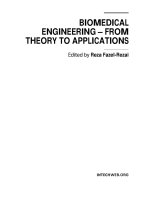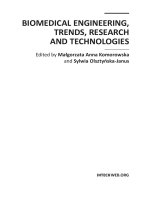Biomedical Engineering Trends Research and Technologies Part 1 ppt
Bạn đang xem bản rút gọn của tài liệu. Xem và tải ngay bản đầy đủ của tài liệu tại đây (929.34 KB, 40 trang )
BIOMEDICAL ENGINEERING,
TRENDS, RESEARCH
AND TECHNOLOGIES
Edited by Małgorzata Anna Komorowska
and Sylwia Olsztyńska-Janus
Biomedical Engineering, Trends, Research and Technologies
Edited by Małgorzata Anna Komorowska and Sylwia Olsztyńska-Janus
Published by InTech
Janeza Trdine 9, 51000 Rijeka, Croatia
Copyright © 2011 InTech
All chapters are Open Access articles distributed under the Creative Commons
Non Commercial Share Alike Attribution 3.0 license, which permits to copy,
distribute, transmit, and adapt the work in any medium, so long as the original
work is properly cited. After this work has been published by InTech, authors
have the right to republish it, in whole or part, in any publication of which they
are the author, and to make other personal use of the work. Any republication,
referencing or personal use of the work must explicitly identify the original source.
Statements and opinions expressed in the chapters are these of the individual contributors
and not necessarily those of the editors or publisher. No responsibility is accepted
for the accuracy of information contained in the published articles. The publisher
assumes no responsibility for any damage or injury to persons or property arising out
of the use of any materials, instructions, methods or ideas contained in the book.
Publishing Process Manager Ana Nikolic
Technical Editor Teodora Smiljanic
Cover Designer Martina Sirotic
Image Copyright Olivier Le Queinec, 2010. Used under license from Shutterstock.com
First published January, 2011
Printed in India
A free online edition of this book is available at www.intechopen.com
Additional hard copies can be obtained from
Biomedical Engineering, Trends, Research and Technologies,
Edited by Małgorzata Anna Komorowska and Sylwia Olsztyńska-Janus
p. cm.
ISBN 978-953-307-514-3
free online editions of InTech
Books and Journals can be found at
www.intechopen.com
Chapter 1
Chapter 2
Part 2
Chapter 3
Chapter 4
Chapter 5
Chapter 6
Preface XI
The Ethical and Legal Contests 1
Conceptual Models of the Human Organism:
Towards a New Biomedical
Understanding of the Individual 3
Stephen Lewis
Factors Affecting Discourse Structure
and Style in Biomedical Discussion Sections 23
Ian A. Williams
Molecular Methods of Analysis 63
An Overview of Analytical Techniques Employed
to Evidence Drug-DNA Interactions.
Applications to the Design of Genosensors 65
Víctor González-Ruiz, Ana I. Olives,
M. Antonia Martín, Pascual Ribelles,
M. Teresa Ramos and J. Carlos Menéndez
Specific Applications
of Vibrational Spectroscopy in Biomedical Engineering 91
Sylwia Olsztyńska-Janus, Marlena Gąsior-Głogowska,
Katarzyna Szymborska-Małek, Bogusława Czarnik-Matusewicz
and Małgorzata Komorowska
Application of Micro-Fluidic
Devices for Biomarker Analysis
in Human Biological Fluids 121
Heather Kalish
Detection of Stem Cell Populations
Using in Situ Hybridisation 139
Virginie Sottile
Contents
Contents
VI
Clinical Advances in Diagnosis 149
Clinical Application of Automatic Gene Chip Analyzer
(WEnCA-Chipball) for Mutant KRAS Detection
in Peripheral Circulating Tumor Cells of Cancer Patients 151
Suz-Kai Hsiung, Shiu-Ru Lin, Hui-Jen Chang,
Yi-Fang Chen, and Ming-Yii Huang
Statistical Analysis for Recovery
of Structure and Function from Brain Images 169
Michelle Yongmei Wang, Chunxiao Zhou and Jing Xia
Cell Therapy and Tissue Engineering 191
Cell Therapy and Tissular Engineering
to Regenerate Articular Cartilage 193
Silvia Mª Díaz Prado, Isaac Fuentes Boquete and Francisco J Blanco
In Vivo Gene Transfer in the Female Bovine:
Potential Applications for Biomedical Research
in Reproductive Sciences 217
Miguel A. Velazquez and Wilfried A. Kues
Nanocarriers for Cytosolic Drug
and Gene Delivery in Cancer Therapy 245
Srinath Palakurthi, Venkata K. Yellepeddi and Ajay Kumar
Biomaterials and Medicines 273
Antimicrobial Peptides: Diversity
and Perspectives for Their Biomedical Application 275
Joel E. López-Meza, Alejandra Ochoa-Zarzosa
José A. Aguilar and Pedro D. Loeza-Lara
Surfactin – Novel Solutions for Global Issues 305
Gabriela Seydlová, Radomír Čabala and Jaroslava Svobodová
Molecular and Cellular Mechanism Studies on Anticancer
Effects of Chinese Medicine 331
Yigang Feng, Ning Wang, Fan Cheung, Meifen Zhu,
Hongyun Li and Yibin Feng
Analytical Methods for Characterizing Bioactive
Terpene Lactones in Ginkgo Biloba Extracts
and Performing Pharmacokinetic Studies
in Animal and Human 363
Rossana Rossi, Fabrizio Basilico,
Antonella De Palma and Pierluigi Mauri
Part 3
Chapter 7
Chapter 8
Part 4
Chapter 9
Chapter 10
Chapter 11
Part 5
Chapter 12
Chapter 13
Chapter 14
Chapter 15
Contents
VII
Fish Lipids as a Source of Healthy Components:
Fatty Acids from Mediterranean Fish 383
Lara Batičić, Neven Varljen and Jadranka Varljen
Flax Engineering for Biomedical Application 407
Magdalena Czemplik, Aleksandra Boba, Kamil Kostyn,
Anna Kulma, Agnieszka Mituła, Monika Sztajnert,
Magdalena Wróbel- Kwiatkowska, Magdalena Żuk,
Jan Szopa and Katarzyna Skórkowska- Telichowska
Characterization of Hydroxyapatite Blocks
for Biomedical Applications 435
Masoume Haghbin Nazarpak,
Mehran Solati-Hashjin and Fatollah Moztarzadeh
Advances in Diagnostics 443
The Use of Phages and Aptamers as Alternatives
to Antibodies in Medical and Food Diagnostics 445
Jaytry Mehta, Bieke Van Dorst, Lisa Devriese, Elsa Rouah-Martin,
Karen Bekaert, Klaartje Somers, Veerle Somers,
Marie-Louise Scippo, Ronny Blust and Johan Robbens
Low Scaling Exponent during Arrhythmia:
Detrended Fluctuation Analysis
is a Beneficial Biomedical Computation Tool 469
Toru Yazawa and Yukio Shimoda
Multi-Aspect Comparative Detection
of Lesions in Medical Images 489
Juliusz Kulikowski and Malgorzata Przytulska
Bioinformatics and Telemedicine 507
Biomedical Adaptive Educational Hypermedia System:
a Theoretical Model for Adaptive Navigation Support 509
Maria Aparecida Fernandes Almeida
and Fernando Mendes de Azevedo
eHealth Projects of the Microgravity Centre 529
Thais Russomano, Ricardo B Cardoso,
Christopher R Jones, Helena W Oliveira,
Edison Hüttner and Maria Helena Itaqui Lopes
Social and Semantic Web Technologies for the
Text-To-Knowledge Translation Process in Biomedicine 551
Carlos Cano, Alberto Labarga,
Armando Blanco and Leonid Peshkin
Chapter 16
Chapter 17
Chapter 18
Part 6
Chapter 19
Chapter 20
Chapter 21
Part 7
Chapter 22
Chapter 23
Chapter 24
Contents
VIII
Extract Protein-Protein Interactions From the Literature
Using Support Vector Machines with Feature Selection 569
Yifei Chen, Feng Liu and Bernard Manderick
Protein-Protein Interactions Extraction
from Biomedical Literatures 583
Hongfei Lin, Zhihao Yang and Yanpeng Li
Technology and Instrumentation 607
Recent Research and Development of Open and
Endo Biomedical Instrument in Surgical Applications 609
Zheng (Jeremy) Li
Critical Issues in Reprocessing Single-Use
Medical Devices for Interventional Cardiology 619
Francesco Tessarolo, Iole Caola and Giandomenico Nollo
Chapter 25
Chapter 26
Part 8
Chapter 27
Chapter 28
Pref ac e
“Biomedical Engineering encompasses fundamental concepts in engineering, biology and medi-
cine to develop innovative approaches and new devices, materials, implants, algorithms, pro-
cesses and systems for the medical industry. These could be used for the assessment and evalu-
ation of technology; for prevention, diagnosis, and treatment of diseases; for patient care and
rehabilitation, and for improving medical practice and health care delivery”. This remarkable
citation a er Wikipedia provides the very essence of the scientifi c and technical fi elds
known as biomedical engineering. Parallel to the technical achievements widely intro-
duced into medicine, scientists are looking for even more effi cient examination methods
for complex biological systems and phenomena at the molecular level. Physicochemical
methods combined with numerous interdisciplinary techniques have been accepted as
powerful tools leading to be er understanding of biological processes and diseases.
This book has been organized in 8 sections corresponding to sub-disciplines within the
biomedical engineering. First chapter in section 1 introduces the ethical and legal con-
texts of medical sciences. The next one contains an analysis of the style of writing the
biomedical papers. Section 2 focuses on methods for the chemical and structural char-
acterization of biomolecules. Four chapters in this section demonstrate how the molecu-
lar spectroscopy can be applied for the structural resolution of biological systems at the
molecular level within cells, organelles and large molecular complexes. The next two
sections deal with novel developments in creation of nanotechnological devices and
introduction of cell therapies. Section 5 contains 6 chapters concentrating on diff erent
types of natural medicines, dietary supplements and also on the study of biomaterials
such as hydroxyapatite. Closing sections 6 and 7 are devoted to the remarkably increas-
ing subdiscipline – bioinformatics. Applications in medical diagnosis are presented in
section 6, achievements in organization, education and information retrieval supported
by informatical tools are described in section 7. Final section is devoted to the techno-
logical and instrumental aids; very interesting discussion is presented focusing on the
question: how far can we expand the application of single use medical devices?
This book is addressed to scientists and professionals working in the wide area of bio-
medical studies from biochemistry, pharmacy to medicine and clinical engineering. The
panorama of problems presented in this volume may be of special interest for the young,
looking for new, original technologies and new trends in biomedical engineering.
December 2010
Prof. Małgorzata Komorowska and Ph.D. Eng. Sylwia Olsztyńska-Janus
Wrocław, Poland
Part 1
The Ethical and Legal Contests
1
Conceptual Models of the
Human Organism: Towards a New
Biomedical Understanding of the Individual
Stephen Lewis
University of Chester
United Kingdom
1. Introduction
Central to the conduct of ethical medical practice is the need to have some conception of
what disease and health might be. It is the concept of disease which prompts medical
intervention and that of health which either prevents unwarranted intervention in the first
place or informs its cessation when the patient is deemed to be well again. As highlighted by
Reznek (1987), it is not only those directly involved in clinical activities who are affected by
these concepts. The work of scientists in medically-related fields can also be directed by how
these concepts are understood. What is and what is not an appropriate project may be
affected by how disease and health are understood with the granting of funds and other
resources similarly affected.
An individual's legal status and the responsibilities expected of them may also be affected
by how they are classified medically. Somebody with a psychiatric disturbance may be
excused for an act which, in others, might be deemed wilfully criminal by virtue of their
condition. Alternatively, somebody with what is classed as a disability may be provided
with financial assistance and/or specialised equipment at public expense. They may even be
excused the expectation of work altogether.
How individuals are labelled medically – how their 'condition' is classified – is important.
However, defining the terms 'disease' and 'health', upon which much of this has rested, has
proven to be extremely difficult and it may well be that an alternative approach is long
overdue.
2. The current biomedical model
The prevailing model upon which much of modern Western medicine relies is the so-called
'biomedical model' (Davey & Seale, 1996). Sometimes this may be shortened to simply
'medical model'. Indeed, the terms tend to be used somewhat interchangeably to refer to the
same way of thinking about the well-being and ailments of individuals. There is certainly no
appreciable difference in the way the terms 'biomedical model' and 'medical model' are
used. In addition, the title 'disease model' may also be sometimes used. This title is perhaps
more telling. One of the central characteristics of Western medical thinking is its emphasis
on disease and with anything else which might be deemed to be 'wrong' with the patient.
Biomedical Engineering, Trends, Research and Technologies
4
As the term implies, the biomedical model is an attempt at combining biological and
medical thinking in the clinical setting. There are two inter-linked ways in which the
biomedical model can be seen working in practice.
Firstly, scientific knowledge gained from non-clinical research is often used to inform
patient treatment. Secondly, clinical practice itself is undertaken in a scientific way by
adopting the same methodology and intellectual rigour as found in pure scientific research.
This approach became typical of the style of medicine practised in the West particularly
during the twentieth century and it has become for us that century's medical legacy. Indeed,
it is still the prevailing model by which the medical profession operates and, as a result, it is
also the way in which people's ailments are understood and treated. Furthermore, this
impacts on the attitude shown to the people affected. Once the medical focus is fixed upon
what is wrong with the patient, that patient can very easily become a bystander and less of a
participant in their own ailments as their bodies are probed and exposed to various
treatments.
Seedhouse (2001) identified in this model the following characteristics:
1. That health is the absence of disease.
2. That health is a commodity with a wide-ranging commercial/business-like dimension.
3. That medical science has produced an accumulation of knowledge which can be
applied to bodies as physical objects rather than to bodies as people.
4. That the best way to cure disease is to reduce bodies to their smallest constituent parts.
5. That health can be quantified in relation to norms for populations, particular groups of
individuals, and individuals.
6. That medicine is and should be a form of engineering.
In essence, the biomedical model explains a patient's ailments as being the result of some
anatomical or physiological cause which, in turn, is deemed to be a fault with the patient's
body. Understanding the causal processes leads directly - or so it is assumed - to
appropriate treatments: remove the cause and one removes the source of suffering and,
subsequently, the suffering itself with the result that the patient is restored to health. The
logic seems reasonable enough and, to an extent, this approach seems to have been
successful. Arguably, the biomedical model has provided clinicians with exactly what they
have needed to do their job: a clear and direct way of approaching the identification and
remedying of their patients' problems. However, this apparent success may be somewhat
illusory.
The emphasis of the biomedical model is on the patient's body. The psychological,
behavioural, social and wider environmental aspects of their ailments are not integrated into
this model – certainly not overtly. Whether or not a particular clinician chooses to include
these aspects is another matter. If they do, it will tend to be at their own discretion and in
their own particular style and manner. Significantly, the biomedical model does not oblige
clinicians to make any such consideration.
Furthermore, the biomedical model fails to recognise and take into account the multi-
factorial nature of cause. If the cause of a patient's ailment is multi-factorial, then effecting
some form of cure is likely to require a multi-factorial approach too. By following this
model, health professionals limit themselves to dealing primarily with the patient's physical
state when other aspects of their lives might need particular attention for complete well-
being to be achieved. For example, a patient may be unwell because of a lifestyle choice such
as over-eating, smoking or excessive alcohol consumption. The simplistic biomedical
remedy is to prescribe a change in diet, a cessation of smoking and a limitation of alcohol
Conceptual Models of the Human Organism:
Towards a New Biomedical Understanding of the Individual
5
consumption to safe levels, respectively. While these recommendations, if adopted, may
well bring about beneficial physical effects in the patient's body, this approach completely
overlooks what might be described as the 'cause of the cause'. The patient's eating, smoking
and drinking habits may stem from some non-physical problem or set of problems to do
with the wider aspects of their life. Factors which may have led to these habits in the first
place are largely ignored. A patient who adopts the recommendation to change their
lifestyle habits in the way described may be physically improved but still have what might
be described as 'quality of life' problems. These, because they fall outside the biomedical
model, are not usually seen as specifically clinical problems and have not become an
integral part of medical thinking. Yet they can impact directly on an individual's overall
well-being.
In the biomedical model, there is also a tacit separation between the mind and the body.
Indeed, a mind-body dualism is arguably central to this model. Exactly why this should be
is unclear. As will be noted below, the biomedical model does not seem to have appeared as
the result of a specific formulation but seems instead to have evolved over a period of time
and while there is a historical and philosophical precedent for a separation of mind and
body in the work of René Descartes (1596-1650), the biomedical separation may have a much
more prosaic explanation. There is a sense in which each individual feels as if they are a
person with or within a body. It is not uncommon for people to use expressions such as 'my
hand' or 'my heart' as if they were objects which belonged to them rather than being integral
parts of them. The linguistic environment within which people operate is not one conducive
to an integration of mind and body but rather one of separation. Thus, to the average
individual, mind and body are not continuous; they are not a unity and it is, therefore, very
easy for people – including clinicians – to make such a separation.
Consequently, the extent to which a patient's experience of pain and suffering are part of the
biomedical model is also a moot point. There is no mention of these in Seedhouse's
characterisation above. That a patient is in some form of distress is only implicit in the
biomedical model in that it is taken for granted that this is what causes people to seek
medical help in the first place. Thereafter, however, once medical help has been procured,
attention is focussed primarily on the cause of the ailment and upon its removal or, failing
this, on the treatment of symptoms until the individual gets well of their own accord. Pain
gets treated quite separately via the provision of analgesia. It does not get considered from a
psychological perspective. The prevailing notion is that pain is experienced because of some
physical cause within the body. Analgesia is given to take away that experience while the
task of removing the physical cause is undertaken. In effect, there is no fully developed
theory of suffering in its wider sense within the biomedical model.
Another effect of the mind-body dualism is an assumption that mind and body can be
treated separately. The body, it is further assumed, can be treated as a machine and a
mechanical metaphor for how it operates can be adopted. Accordingly, the biomedical
model assumes that diseases can be characterised as resulting from identifiable physical
causes – that is, there must be a mechanical element to disease. As a corollary to this, it is
assumed that applying ever more sophisticated technological investigations in determining
the mechanical nature of the disease can only be to the increasing benefit of the patient.
However, this may not necessarily be the case. Tinetti and Fried (2004) have noted that “(a)
primary focus on disease inadvertently leads to undertreatment, overtreatment, or
mistreatment”. Confronted with this, it may well be the clinician who, in fact, benefits most
from these technological advances – or at least some of them. Being better informed does not
Biomedical Engineering, Trends, Research and Technologies
6
necessarily lead to better treatment. What an extensive battery of diagnostic tests certainly
can do is allow clinicians to guard themselves against liability for misdiagnosis and
inappropriate choice of treatment.
Historically, the biomedical model never had a single definitive founding moment. Instead,
a series of events in the history of biology and medicine appear to have contributed to its
gradual emergence. These include the work of Giovanni Battista Morgagni (1682-1771) in
founding the field of pathology in the eighteenth century, the general progress made in
establishing physiology as a science in the nineteenth century (with the work of Claude
Bernard (1813-1878) occupying a significant and enduring position as a forerunner to the
notion of homeostasis developed by Walter Cannon (1871-1945) in the 1920s) and the
specific proposals about the nature of medical training made early in the twentieth century
in the Flexner Report (1910). However, as Keating and Cambrosio (2003) have noted "… the
object of medicine is not the body per se but, rather, models of the body". The emphasis that
the biomedical model places on the body is, in fact, an emphasis on a model of the body: an
abstraction.
The models we use influence and may even drive our understanding of the object to which
those models apply. Here, our models of the human body influence the practice of medicine
itself. Until the nineteenth century, the prevailing model of the body in Western medicine
was based upon the ancient notion of humoralism. How well or unwell one felt was thought
to be the product of the way in which four supposed bodily humors – black bile, yellow bile,
phlegm and blood – were in proportion to each other. Therapies and treatments were
delivered not in accordance with physical observations about the nature of the body alone
but in terms of how these observations were interpreted in terms of humoral theory. For
example, if a patient's ailment was deemed to be related to an excess of the humor blood,
this excess was alleviated by subjecting them to the process of blood-letting. Any anaemia
that may have resulted from this process seems to have gone unnoticed. While we have
moved on since then to become more accurately informed about the true physical nature of
the body, we still adhere to conceptual models via which to operate, as the example of the
biomedical model illustrates. Any model by which we operate is an abstraction from what is
currently known. As a result, such models are always in need of refinement as knowledge
and understanding develop.
Given this historical background, one might reasonably expect the biomedical model to be
something which continues to evolve and to be refined as new knowledge and
understanding emerge. While research does produce new findings from which new
treatments and therapeutic techniques are developed within the context of the current
model, the conceptual basis upon which the biomedical model is founded appears to be
somewhat more static. Arguably, the biomedical model has not, strictly speaking, kept pace
with wider intellectual developments. In practice, it is now quite clear that the cause-effect
relationship does not hold. Frequently, clinicians are confronted with patients whose
ailments are without apparent physical cause. Similarly, routine screening can bring to light
potentially life-threatening lesions for which there is an absence of any experienced
symptoms. Those conditions which cannot be accommodated by the biomedical model often
cause clinicians considerable problems in terms of decision making (Marinker, 1975). Yet,
the central cause-effect assumption remains. This reflects, in part at least, a too rigid
application of the wider scientific expectation that all observable phenomena within the
physical universe are explicable in physical terms. It is questionable whether the body, even
if seen merely as a set of physical processes, really operates in quite that way.
Conceptual Models of the Human Organism:
Towards a New Biomedical Understanding of the Individual
7
One is compelled to ask not only to what extent the prevailing biomedical model is useful in
contributing to clinical practice but also to what extent this model truly represents the
biology of the individuals concerned. Ailing, in the absence of apparent physical cause, and
the absence of symptoms, in the presence of life threatening lesions, seem to refute the
viability of the biomedical model as currently formulated. Indeed, the conceptual bases
upon which much of Western medicine is founded may not be as sound as might be
expected.
One of the core problems with the prevailing biomedical model is its focus on disease.
Health, it tends to be assumed, is merely the absence of disease. In effect, something that
exists because of the absence of something else – some sort of default status. This is in
contrast to the constitutional statement of the World Health Organization which holds that
'(h)ealth is a state of complete physical, mental and social well-being and not merely the
absence of disease or infirmity' (WHO, 1948). While the first part of this statement has its
critics, the latter clause tends to receive little criticism. Those whom one might have
expected to be most exercised by the problem of defining the notions of health and disease –
because they are core to their professional practice – are those who seem least interested in
their conceptual foundations. When posing the question 'What is health?' Richard Smith,
editor of the British Medical Journal (BMJ) stated that '(f)or most doctors that’s an
uninteresting question. Doctors are interested in disease, not health. Medical textbooks are a
massive catalogue of diseases.' However, when it comes to diseases, defining what these are
seems to be equally difficult as surveys published in the BMJ have discovered (Campbell et
al., 1979; Smith, 2002). Offered a list of named conditions with which clinicians frequently
deal, different groups of people – including medical academics and general practitioners –
were asked to say which they thought were diseases and which they thought were not.
Noticeably, there was not complete agreement. There were differences of opinion within
and between the groups surveyed. Clearly, deciding whether something merits being called
a disease is not a simple proposition.
One finds there to be in the philosophy of medicine, however, much more debate about how
to define the terms 'disease' and 'health' with two different schools of thought having
emerged (Nordenfelt, 1986; 2007a,b). One school of thought, sometimes called
'descriptivism' or 'naturism' because it holds that disease and health can be understood in
physical terms, is represented by the work of Christopher Boorse (1975; 1977; 1997). His
work has been particularly prominent within this debate and is in some respects a
formulation of the biomedical model. There is certainly a pathological and physiological
emphasis within Boorse's description of what constitutes disease. The other school,
sometimes called 'normativism' because it sees the ascription of the terms 'disease' and
'health' as labels expressing a value-judgement, has come to be associated with the work of
Lennart Nordenfelt (Khushf, 2007). While not overlooking the pathological and
physiological, Nordenfelt takes a different approach. His emphasis is on health and, using
action theory, the individual's ability to achieve various 'vital goals' associated with daily
living.
A simple dichotomy between health and disease – or of being well and unwell – seems to
pervade biomedical thinking which has become somewhat linear in nature. In various
pictorial descriptions, a simple line is used to represent the health-disease (well-unwell)
dichotomy (Seedhouse, 2001; Downie et al 1996). This is also, arguably, a tacit assumption
within the philosophical debate about the definition of disease and health. Health and
disease are largely seen as dichotomous categories into which patients may be placed. By
Biomedical Engineering, Trends, Research and Technologies
8
portraying 'disease' and 'health' in this way, as if at opposite ends of a single axis, the
biomedical model has not contributed to the resolution of the philosophical debate and
finding philosophically rigorous definitions of these terms remains elusive. Indeed, it may
be argued that the biomedical model, at least as currently formulated, has contributed to the
apparent obfuscation. At best, the biomedical model can only be said to provide a heuristic
by which clinicians work.
Sadegh-Zedah (2000) has strongly criticised this bipartite 'either-or' aspect of thinking about
disease and health. This he attributed to an uncritical adherence to another aspect of
scientific thinking, Aristotelian logic with its law of the excluded middle. Instead, he
suggested, it might be more appropriate to apply Fuzzy Logic recognising a continuity
between the two extremes. Adhering to the dichotomy – and even allowing for this
continuity – means that those scenarios described above, which cannot be accommodated by
the biomedical model, are still simply left in abeyance.
The healthy or 'well' state is also assumed to be the 'normal' state; the diseased or 'unwell' is
assumed to be the 'abnormal' state. This attitude, deemed to be currently prevailing in
medical schools and textbooks, has been labelled 'Naïve Normalism' (Sadegh-Zedah, 2000).
The prescription of normal and abnormal states is typically undertaken by comparison to
population means for given anatomical or physiological parameters. Deviations outside
prescribed limits either side of these statistical means forms a basis for clinical concern. The
individual is constantly compared to others in order to determine what is and what is not
'normal' for them. However, as Sadegh-Zedah (2000) has also pointed out, what 'normal'
really is – apart its numerical interpretation – remains unclear.
3. The biopsychosocial model – an attempt at improvement
One of the most prominent critics of the biomedical model and advocate for change was the
American psychiatrist, George Engel (1913-1999). Having identified the need for a new
model (Engel, 1977), he proposed an alternative: the biopsychosocial model (Engel, 1981;
1997). Engel intended this model to be a "conceptual framework to guide clinicians in their
everyday work with patients" (Engel, 1997) as well as a framework for a wider more
scientific understanding of what he called the "human domain". That is, a model to act as a
general framework to guide theoretical and empirical exploration, not only of processes or
states that are called illnesses or diseases but something more inclusive when trying to
understand the human condition as a whole. Importantly, Engel's work highlighted how
easy it is to forget that it is a person who is central to any understanding of suffering and its
causes. It is not only the physical processes involved when an individual is feeling unwell
that should command centre stage but a whole range of features at a number of different
hierarchical levels of interaction (Figure 1). It is the individual as a whole – as a physical
organism and as a person interacting with the world around – that is essential to any
understanding of the notions of disease and health.
Despite initial optimism when first proposed, the biopsychosocial model failed to find the
key role in clinical medicine for which it was intended. While Engel's ideas still attract
followers (see, White, 2005), his proposals have met with limited success and have not fully
entered mainstream medical thought. The main legacy of that model appears to be that the
term 'biopsychosocial model' has come to be used to mean something akin to 'holistic'.
When the term 'biopsychosocial' is used, it is more likely to be as a form of shorthand
implying 'widely-inclusive' or 'all-encompassing' rather than offering a way of detailing
what is going on at the different levels Engel had envisaged.
Conceptual Models of the Human Organism:
Towards a New Biomedical Understanding of the Individual
9
Fig. 1. The Systems Hierarchy (Levels of Organisation) of the Biopsychosocial Model (after
Engel, 1981)
The biopsychosocial model does improve upon the standard biomedical model in that it
recognises a link between mind and body. The two influence each other but exactly how is
unclear. The biopsychosocial model does not set out to explain what the mechanisms
involved might be. This is, perhaps, a good thing. To have speculated was not strictly
necessary and to have speculated and found to be wrong would have cast a shadow over
the rest of his ideas. Instead, the biopsychosocial model recognises there to be a link
between mind and body in a somewhat more empirical way.
The biopsychosocial model is not without its critics. It has been criticised for not explaining
how the levels Engel highlights interact (Malmgren, 2005). It is true that the biopsychosocial
model does lack what might be called a theory of the organism. The list of different levels at
which different effects may be observed is left without a detailed explanation of the way in
which these levels influence each other being given. The biopsychosocial model is able to
accommodate a good deal of information about what occurs at each level as was
demonstrated using the clinical example of a myocardial infarction (Engel, 1981). However,
its explanatory and predictive capabilities are quite limited. Indeed, Engel's model begs the
question of how much detail is necessary in order to understand the organism as a whole.
Instead of a series of hierarchical levels, an alternative is to conceive of a series of nested (or
Chinese) boxes (Grobstein, 1965). Where Engel encounters a problem is that his readers
require of him an explanation of how the different levels – or nested boxes – influence each
other (Malmgren, 2005). It may not be strictly necessary for all the minutiae to be explained
before an acceptable picture of the organism emerges. Might one reasonably choose instead
to put a lid on one or other of the boxes and to view the operation of each box separately
Biomedical Engineering, Trends, Research and Technologies
10
without going into the finer detail of the workings within? Indeed, the biopsychosocial
model owes much to Ludwig von Bertalanffy's (1901-1972) 'General Systems Theory'
(Malmgren, 2005). In such an approach, it is usually more informative to explain the
behaviour of a system as a whole. Such behaviour is not merely the summation of the
behaviour of the parts. Emergent properties may only manifest themselves at certain levels
of organisation and might be missed by looking too deeply at fine detail.
In engineering, a black box is a something which can be viewed purely in terms of its input,
output and the transfer function that gives the relationship between the two rather than in
terms of the details of internal operation. There need be no knowledge of the processes
occurring within the black box for it to be understandable in some way (Figure 2). Instead of
requiring increasingly precise amounts of information about different levels of organisation,
it may be more desirable, in order to understand a system as a whole more clearly, to put a
lid on one of the conceptual boxes and deliberately ignore what lies within. This produces a
form of black box. More appropriately, perhaps, one might refer to this as a 'closed box'.
'Closed', that is, in the sense that the contents and their various processes are hidden from
view and 'closed' in the sense that the lid has been deliberately put on. This is a somewhat
counter-reductionist approach. While Engel attempts to look at all levels associated with the
individual simultaneously, a way of understanding just the individual as a single whole
may prove to be a better starting point.
Fig. 2. A Black Box. Only the input and output are known and, as a result, the
transformation that has taken place within the black box.
4. Another way ahead
Despite various criticisms, the biomedical model still occupies a prominent place in Western
medicine. Indeed, it has proved useful despite its flaws and its complete removal or
replacement is likely to prove virtually impossible as Engel's attempts with the
biopsychosocial model have demonstrated. The persistence of the biomedical model is,
perhaps, not surprising. It has, in many respects, withstood the test of time, having been
very successful in acting as a useful - if imperfect - heuristic. However, that is not to say that
Conceptual Models of the Human Organism:
Towards a New Biomedical Understanding of the Individual
11
the biomedical model cannot be improved. Instead of attempting a complete replacement, a
more productive approach might be to build upon its useful features, correct its flaws and
expand it as necessary. A revision of the existing biomedical model is needed. Such a
revision would need to ensure that there was a firm foundation in biological science such
that a range of biomedical and biomechanical disciplines could operate in a more informed
manner when dealing with individual patients.
Although the name biomedical model suggests that there is already a strong biological
component, not every aspect of biology pertinent to medicine can be said to have been
utilised by this model. For example, it is only in recent years that the need for a place for
evolutionary biology in medicine has been highlighted with the emergence of the field of
evolutionary (Darwinian) medicine - and that well over one hundred years after the
publication of Darwin's 'On The Origin of Species' (see, for example, Williams & Nesse 1991;
Nesse & Williams, 1995, 1999; Nesse, 2001a,b; Nesse et al., 2006).
Out of a consideration of the range of ideas that evolutionary biology can bring to medicine
comes the question of the relationship between the notion of individual 'survival' and a
patient's overall state as an integrated physical, experiential and interactive system.
'Survival' should not be seen as simply a matter of whether or not one can stay alive. There
is a 'quality of life' element as well which influences whether one merely survives in the
sense of just barely staying alive or whether one survives well and flourishes. It is in the
latter context that the biological imperative of reproduction can be best performed. For
example, those female animals which are required to invest much of themselves in
producing and raising offspring would, if experiencing a low quality of life, be less likely to
succeed in bringing many to full reproductive maturity. In seeking medical help, an
individual is, in effect, seeking help with their quality of life – although not, of course,
necessarily with the aim of enhancing reproductive success in mind. Somebody who visits
their doctor with an ailment is, in effect, acknowledging a diminution of some perceived
aspect of their quality of life. Thus, what biology has to say about this in relation to notions
of survival and quality of life is relevant to medical practice.
As a result, one may reasonably propose that one should first seek to understand, in
biological terms, what contributes to the individual's quality of life via an examination of the
notion of individual survival before going on to try to define the notions of 'disease' and
'health' per se.
4.1 On modelling
The need to explain complex systems such as the human body in disease and in health leads
to the development of models which in themselves are interpretations of reality. All models
are, by their very nature, abstractions. A drawing of a bird that is intended to help bird-
watchers identify different species is, in effect, a model, an abstraction. Such a drawing is
not an exact likeness of any particular bird that one is likely to see. Rather it is a
representation of a whole species. There is, in that drawing, a certain generality.
Similarly, in medicine, it is necessary to identify different types of people. Firstly, there are
those who should and those who should not be classified as 'patients'. Secondly, of those
who should be classified as patients, it is necessary to differentiate between different types
of patient. That is, those who are in need of different kinds of medical attention. A way of
distinguishing between these different categories is needed. However, the distinction
between 'patient' and 'non-patient' need not mirror the dichotomy between 'disease' and
Biomedical Engineering, Trends, Research and Technologies
12
'health' – which seems to be what the biomedical model seeks to do. Help with enhancing
one's quality of life is broader than this.
One must be clear about the purpose of making models. Two major types of model may be
identified. These may be described as 'Models of' and 'Models for'. 'Models of' are those
models which simply describe an object or process in simplified (although not necessarily
simplistic) terms. 'Models for' are those models which have been constructed with a
particular purpose in mind. 'Models for' may also share some of the characteristics of
'models of' type models. They may include some form of description of an object or process
which then provides something with a practical use. Astrophysical models of star or black
hole formation, for example, are models of how something happens but these models may
have no immediate practical usefulness on Earth. Models of physiological processes can be
models of what occurs within a body and can be of purely theoretical interest – especially if
that process occurs in a species quite unlike our own. However, when they are applicable
clinically, some physiological models allow for understanding a patient's
pathophysiological processes better and may help in remedying their ailments more
effectively. It follows that it is of paramount importance in the medically-related fields that
the best possible models are devised in order to provide the best possible patient care.
5. Understanding the individual in two biomedical dimensions
In organismal terms, human individuals are not simply physical objects or even sets of
physical processes; they are persons – minds as well as bodies. In particular, an individual
can be considered as having two concurrent and interwoven characteristics. Firstly, the
individual is a materially self-referential system in that there are numerous physiological
processes that are monitored and regulated at a physical level via different forms of
feedback. Secondly, the individual is experientially self-aware in that conscious and also
sub-conscious monitoring and regulation are also being affected at a higher level. If, for
example, the body becomes dehydrated, this is not merely a physical change accompanied
by concomitant physiological responses. There is also a higher level experience of 'thirst'.
Biologically, being 'known' to oneself in these various ways allows the individual to respond
accordingly so as to ensure continued survival – in this example, by drinking.
5.1 The physical dimension
At the non-conscious physical level, biochemical and physiological pathways and their
regulatory mechanisms are involved. It is with these that the current biomedical model is
largely concerned - with much of the emphasis being confined to biochemical and
physiological detail. However, if considered from an organismal perspective, these
processes have a much greater significance. They can operate in such a way as to ensure
organismal survival or they can operate in a way that endangers the survival of the whole
organism – or any gradation in between. If these processes work en masse so as to ensure
survival, we may consider this form of operation to be 'ordered' or 'orderly'. If these
processes do not work en masse to ensure survival, we may consider this form of operation
to be 'disordered' or 'disorderly'. The criteria for conferring these appellations are quite
simple, being based on the overall effect on the survival of the individual as an organism. By
concentrating on biochemical or physiological detail alone, it is easy to overlook the
organism-level role played by the numerous physiological processes occurring within the
human body simultaneously. Here one seeks to avoid this by using the black box approach
Conceptual Models of the Human Organism:
Towards a New Biomedical Understanding of the Individual
13
described above. One is looking primarily at how the whole organism operates, not the sum
of its parts. One has closed the box at organism level.
5.2 The experiential dimension
Human beings also have a capacity for self-awareness. They are conscious of how they feel.
In particular, the ability to feel unwell or otherwise distressed seems to be especially
significant as these experiences are often indicative of some physical disorder. Raised to the
conscious attention of the individual, remedial action is possible. While consciousness may
be something that concerns the psychologist or the philosopher, the notion of self-awareness
is something that has been rather under-represented in biology - especially in relation to the
experience of illness (Lewis, 2007a,b) - and, unsurprisingly, is missing from the biomedical
model. This is unfortunate as this is an important capacity for an organism to possess.
Without the capacity for self-awareness - at conscious and/or sub-conscious levels - one
would lack the ability to be aware of any need to respond to disadvantageous changes in
one's internal environment. Should this capacity become disturbed, it would impact
negatively on individual survival.
Although akin to the separation of mind and body, this division into physical and
experiential is subtly different. The notion of 'mind' usually implies consciousness and
cognitive self-awareness. Within the experiential dimension as envisaged here, all
organismal feedback mechanisms are included whether or not one is aware of them.
5.3 A two-dimensional (biomedical) model
The two dimensions described above may be represented graphically as a plane as depicted
in Figure 3 (Lewis, 2009). Importantly, the axes are arranged so that, as one moves along
Fig. 3. A new two-dimensional biomedical model









